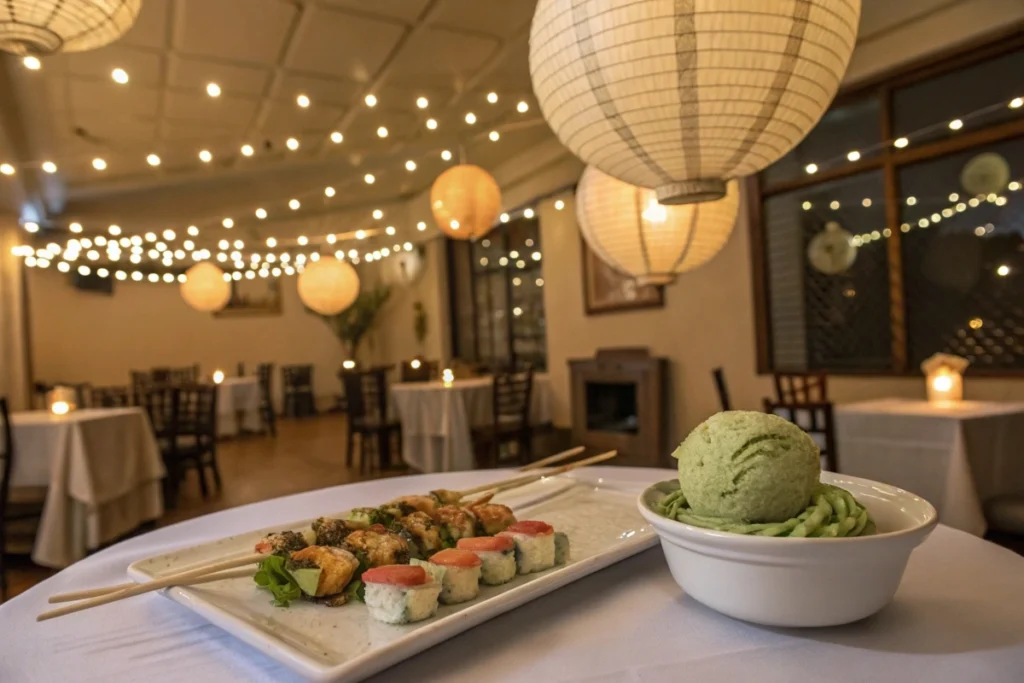Introduction
Are you looking to impress your guests with a spread that’s both eye-catching and delicious? Japanese party food offers a perfect blend of visual appeal, mouthwatering flavors, and cultural uniqueness. From sushi platters to savory yakitori skewers, Japan’s culinary scene provides an endless array of crowd-pleasing dishes suitable for gatherings of all sizes. Whether you’re hosting an intimate get-together or a big celebration, Japanese-inspired fare can instantly elevate your party to a memorable event.
One of the best things about japanese party food is its versatility. You can go fully traditional with classics like gyoza (dumplings) and onigiri (rice balls), or you can experiment with modern fusion ideas like teriyaki sliders or sushi bake casseroles. The emphasis on fresh ingredients and balanced seasonings means you’re offering not just tasty bites but also a relatively healthier alternative compared to greasy fast foods.
In this comprehensive guide, you’ll learn about why Japanese dishes fit perfectly into party settings, discover top recipes and plating styles, and pick up tips on decoration ideas that channel the aesthetic charm of Japan. If you’re a beginner in Japanese cooking, no worries—Explore easy Japanese recipes to start building your repertoire and transform your next gathering into a culinary voyage through the Land of the Rising Sun.
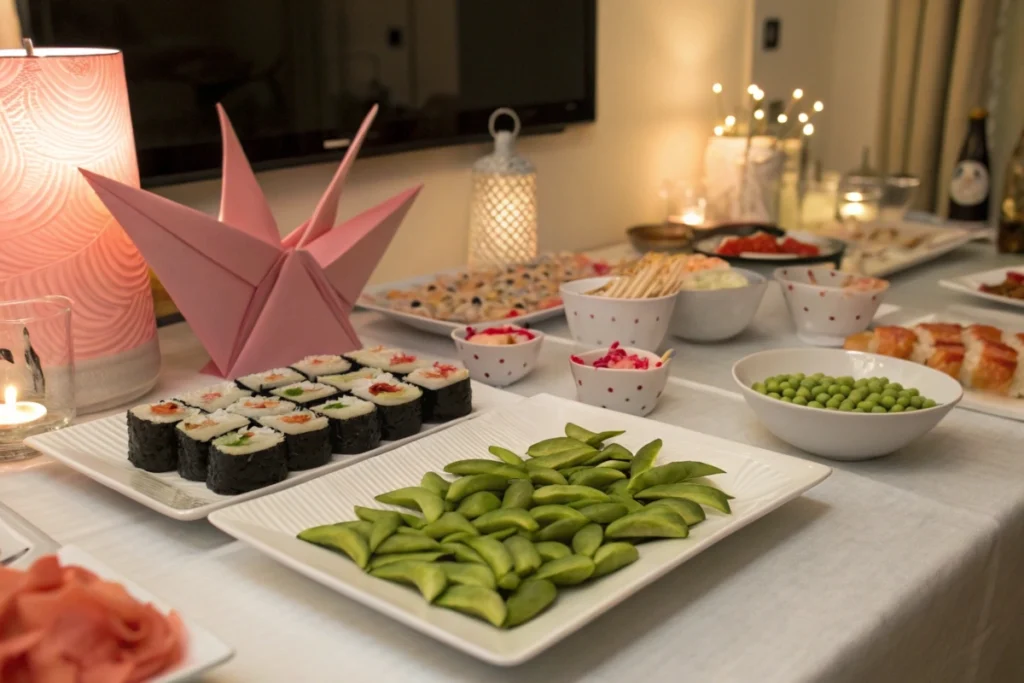
1. Why Japanese Party Food?
Throwing a memorable party often comes down to one critical element: the food. The aesthetic and taste of japanese party food make it an excellent option for hosts wanting to create a unique, enjoyable experience. Here are key reasons to consider incorporating Japanese dishes into your next event:
Versatility & Variety
Japan’s culinary repertoire offers an extensive range of dishes suitable for all taste buds. From light appetizers like tsukemono (pickled vegetables) to hearty main courses such as rice bowls or karaage (fried chicken), you can assemble a diverse menu that satisfies vegetarians, meat-lovers, and even those with gluten-free preferences.
Cultural Appeal
Japanese dining customs emphasize sharing and presentation, which aligns well with party scenarios. Serving small plates or bite-sized portions fosters a communal feeling, encouraging guests to explore multiple flavors. Traditional plating techniques also highlight color contrasts and seasonal themes, reflecting the essence of Japanese aesthetics.
Health-Conscious Options
While party foods often get a reputation for being heavy on fat or sugar, many Japanese recipes prioritize fresh ingredients and moderate seasoning. For example, yakitori (grilled chicken skewers) rely on lean meat and minimal oil, while sushi focuses on high-quality seafood and nutrient-rich seaweed. This balance ensures that guests can indulge without feeling overwhelmed by overly rich options.
Easy to Customize
Hosts can adapt many Japanese dishes to suit dietary needs or personal taste. Toppings, sauces, and fillings can be tweaked to incorporate local or seasonal produce. Perhaps you want to create a vegetarian sushi platter or add spicy sauces to your rolls—nothing is stopping you from innovating while still preserving the core of Japanese flavors.
For seafood lovers, a more specialized approach might include shellfish. Check out how shrimp transforms any meal in Japanese shrimp recipes for additional inspiration. Experimenting with such ingredients can further distinguish your party from standard buffets.
The “Wow” Factor
Japanese cuisine is undeniably eye-catching. Imagine a table filled with colorful sushi, steaming bowls of miso soup, and elegantly arranged tempura. The visual feast alone creates a conversation starter and elevates the mood. This unique aesthetic, combined with rich taste, ensures your event will stand out.
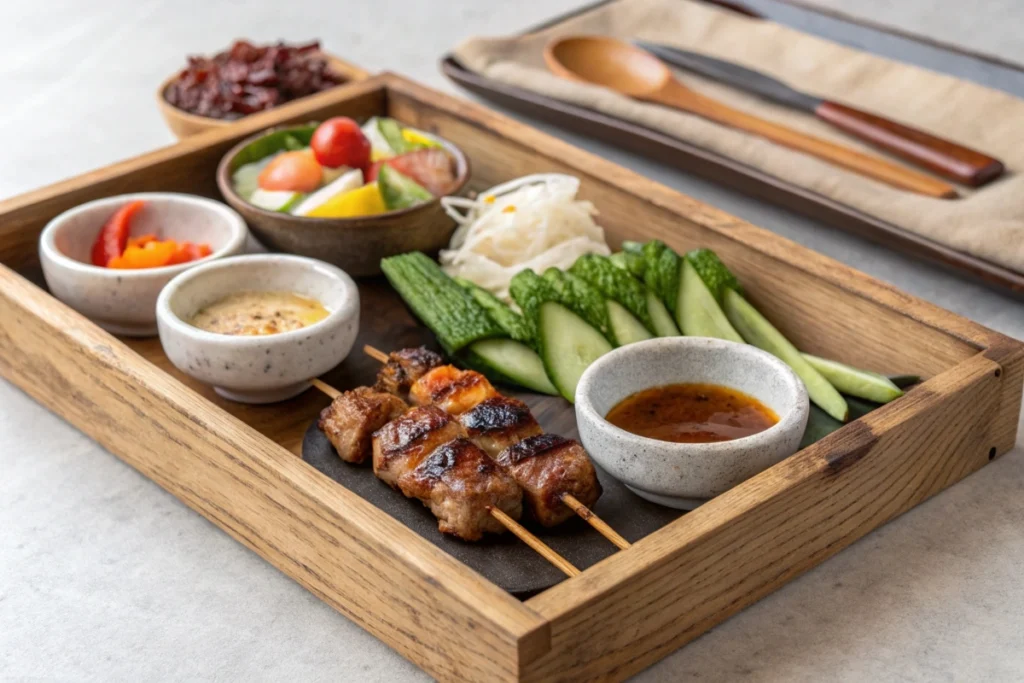
2. Crowd-Pleasing Dishes: Sushi, Skewers, & More
When it comes to building a spread of japanese party food, it helps to start with star attractions. Few dishes embody Japanese cuisine’s balance of flavor and presentation like sushi, while skewers and fried delights add variety. Let’s explore some crowd favorites:
Sushi: The Ultimate Party Icon
- Classic Rolls: California rolls, spicy tuna rolls, or salmon rolls are beginner-friendly. These options appeal to a broad range of palates, thanks to their mild yet satisfying flavors.
- Nigiri & Sashimi: For more traditional flair, serve fresh cuts of fish atop vinegared rice (nigiri) or as sashimi without rice. This approach works best when you have access to top-quality seafood.
- Sushi Bake Casseroles: Inspired by modern fusions, a sushi bake is a layered rice and seafood dish that you bake in an oven, then scoop onto small squares of nori. It’s easy to prep in large batches—perfect for bigger gatherings.
Skewers: Yakitori & Beyond
- Yakitori (Chicken Skewers): A staple in izakaya bars, yakitori can be seasoned with salt (shio) or sweet soy sauce (tare). They’re bite-sized, portable, and can be served hot or at room temperature.
- Tsukune (Chicken Meatballs): Another variant of yakitori, tsukune is formed into meatballs and grilled on skewers. This slightly sweet, glazed treat pairs beautifully with sake or beer.
- Seafood Skewers: Shrimp, scallops, or squid can be quickly grilled. A light brush of soy sauce or teriyaki glaze rounds out the flavors.
Fried & Savory Morsels
- Tempura: A golden, crisp batter enveloping vegetables or shrimp. Be sure to have dipping sauce (tentsuyu) and grated daikon radish on hand.
- Karaage (Japanese Fried Chicken): Marinated in ginger, garlic, and soy sauce, then deep-fried until crispy. Karaage is tender on the inside and often served with lemon wedges.
- Gyoza (Dumplings): Pan-fried on one side and steamed to finish, these dumplings usually contain a filling of cabbage, ground pork, and seasonings. They’re easy to batch-cook and serve with a tangy dipping sauce.
For a sweet contrast, you might include a small dessert station. Discover advanced dessert pairings to finalize your menu. Offering mochi or mini matcha cheesecakes can add a refreshing end to a savory meal.
Presentation Tips
- Serve Varied Colors: Japanese cuisine values visual harmony, so mixing green, orange, and golden hues can make your platter pop.
- Use Small Plates: Encourage guests to sample multiple items by providing petite plates or communal platters.
- Include Sauces: Teriyaki, ponzu, wasabi mayo—having these on the side helps guests customize their flavors.
By mixing sushi, skewers, fried bites, and a dash of sweetness, you’ll have an irresistible japanese party food lineup that meets everyone’s cravings.
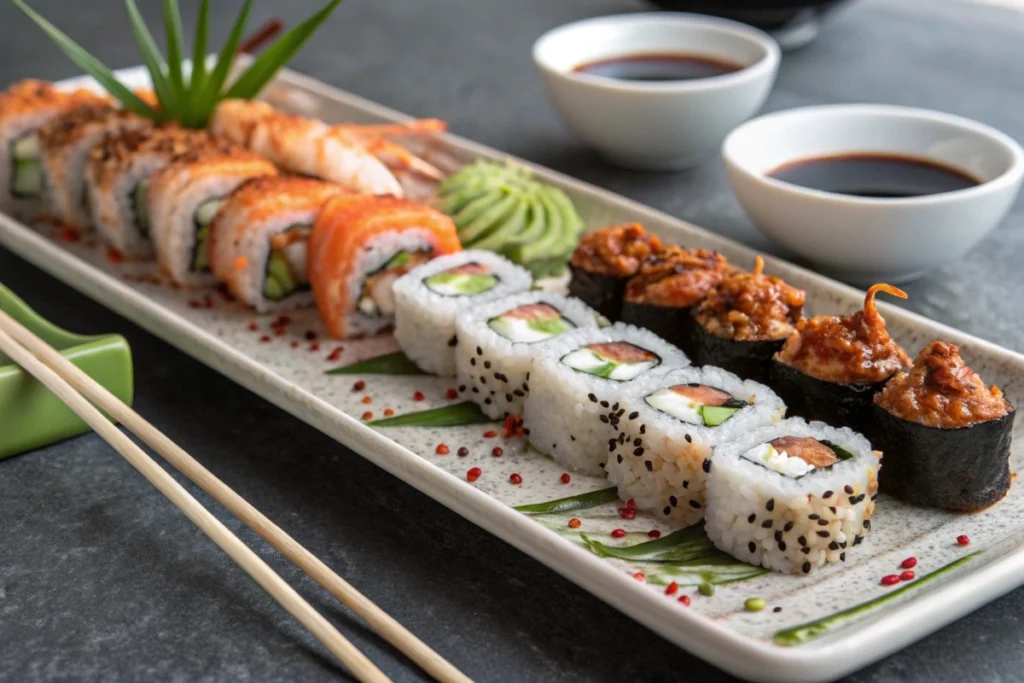
3. Japanese Sides & Platters: Elevating the Experience
No party menu is complete without side dishes and platters that cater to snacking or fill-in gaps between the main courses. Japanese party food is renowned for delivering sides that are simple to make yet impactful in flavor.
Quick and Easy Sides
- Edamame: Lightly salted edamame pods are a classic bar snack. They’re easy to prepare—just boil or steam until tender. A sprinkle of sea salt or shichimi togarashi (seven spice) adds a subtle kick.
- Cucumber Sunomono: Vinegar-based salads with thinly sliced cucumbers. Crisp and refreshing, these salads cleanse the palate between heavier bites.
Salad Platters
- Seaweed Salad: Wakame-based seaweed salads provide a savory taste of the ocean. Dress them in sesame oil, vinegar, and soy sauce for an umami-rich bite.
- Daikon-Carrot Slaw: Grate daikon radish and carrot, then toss them with a sweet-sour dressing. This bright, crunchy mix pairs well with fried items.
Rolls and Wraps
- Onigiri (Rice Balls): Shaped triangles of salted rice often contain fillings like tuna mayo or pickled plum. Wrap them partially in nori for easy handling.
- Maki Rolls: Beyond sushi staples, you can create veggie-forward rolls with grilled eggplant, avocado, or pickled radish (takuan).
For additional vegetable sides, explore how Japanese vegetables inspire hearty dishes that can complement your spread.
Presentation Matters
Arranging your sides on wooden boards or black ceramic dishes accentuates the clean, minimalistic vibe that defines Japanese aesthetics. Label each item with small name cards to help guests identify unfamiliar ingredients.
Extra Touches
Consider offering a communal soup station, such as miso soup, in small cups. It’s a comforting addition to a primarily finger-food-based menu. You could also add small bowls of pickles or kimchi, acknowledging Japan’s culinary exchange with neighboring countries like Korea.
Whether you’re setting up a buffet line or placing smaller plates around your venue, these sides help round out the menu. The variety and depth of flavors ensure guests have plenty of options to nibble on throughout the night.
4. Fusion Ideas & Themed Decor
If you want your japanese party food event to stand out, consider blending traditional dishes with modern touches and decking out your venue with complementary decor. The result is a stylish, theme-oriented party where cuisine and ambiance work in harmony.
East-Meets-West Culinary Twists
- Teriyaki Sliders: Swap out plain beef patties for mini burgers glazed with teriyaki sauce. Top with a slaw of shredded cabbage and carrot for crunch.
- Japanese Tacos: Use tortillas but fill them with tempura shrimp or grilled yakitori chicken, along with pickled ginger or wasabi mayo.
- Ramen Bar: Instead of a standard buffet, set up a ramen station. Offer various broths (miso, shoyu), proteins (chashu pork, tofu), and toppings (scallions, nori) so guests can customize bowls.
Thematic Decor
- Cherry Blossom Elements: Pink and white blossoms or artificial branches can evoke the feel of a sakura festival. Hang paper lanterns to add soft lighting.
- Japanese Tableware: Incorporate bamboo mats, ceramic plates, and lacquered trays to create a sense of authenticity.
- Origami Place Cards: Simple paper-folded cranes or flowers can serve as name holders, blending function with artistry.
Activities & Games
- Sake Tasting: Offer small cups of different sake varieties (junmai, ginjo, daiginjo) to spark conversation and curiosity.
- Tea Ceremony Demo: For a quieter event, a short demonstration or tasting of matcha tea can bring cultural depth.
- Japanese-Themed Party Games: You might include chopstick races (where players transfer small items using chopsticks) or quiz sessions about Japanese traditions.
For more advanced party ideas, discover Japanese new year recipes that hold symbolic significance. While not strictly fusion, they can become conversation starters at a themed party.
Tips for Success
When combining cuisines, taste-test your innovations beforehand. A dish that sounds great on paper may need minor adjustments to balance flavors. Similarly, ensure your decor doesn’t overshadow the food; it should complement the dining experience, not compete with it.
By embracing fusion ideas and paying attention to thematic details, you create an immersive experience. Guests not only enjoy delicious bites but also feel transported into a culturally rich setting—truly a party to remember.
5. Sweets & Beverages: Finishing in Style
A Japanese party isn’t complete without desserts and drinks that tie the menu together. From soft mochi to distinctive cocktails, these finishing touches can leave guests with a lasting impression of your japanese party food event.
Desserts to Delight
- Mochi Ice Cream: Small balls of ice cream wrapped in chewy mochi dough. Available in flavors like matcha, strawberry, or red bean.
- Matcha Cake or Cookies: For those seeking a less traditional spin, infuse green tea powder into Western-style desserts. A hint of matcha can add an earthy note and appealing green hue.
- Dorayaki: Pancake-like pastries stuffed with sweet azuki bean paste. Perfect for bite-sized indulgence if cut into small wedges.
For an even broader selection, browse Japanese dessert recipes that you can adapt for party-friendly portions—like mini tarts or cake squares.
Beverage Selections
- Sake: Japan’s signature rice wine offers a range of profiles, from dry (karakuchi) to sweet (amakuchi). Serve chilled or at room temperature in small cups.
- Shochu Cocktails: Distilled from barley, sweet potatoes, or rice, shochu can be the base for refreshing cocktails. Mix with citrus juices, soda, or fruit syrups for a light beverage.
- Non-Alcoholic Drinks: Offer green tea or barley tea (mugicha) for guests who prefer to skip alcohol. You can also infuse regular water with lemon slices or cucumber for a fresh twist.
The Art of Pairing
To complement sweeter treats, a mild sake or lightly roasted tea can help cleanse the palate. If you’re serving matcha-infused desserts, consider pairing them with a milder beverage so flavors don’t clash. Conversely, robust flavors like chocolate-based sweets may stand up well to a richer sake or even a Japanese old-fashioned cocktail.
Serving Tips
- Presentation: Arrange desserts on tiered stands or lacquered trays for an upscale vibe.
- Portions: Stick to smaller sizes so guests can sample multiple options without feeling too full.
- Timing: Bring out dessert and beverage stations once the main savory courses wind down.
By selecting the right sweets and beverages, you ensure that every aspect of your party flows seamlessly from start to finish. The final bites and sips leave your guests satisfied, showcasing the diversity and depth of Japanese cuisine—even in something as seemingly simple as dessert and drinks.
History & Context of Japanese Party Food
Throughout Japan’s long culinary history, food has played a central role in celebrations, community gatherings, and religious festivals. Japanese party food has evolved in tandem with social customs, merging ancient traditions with global influences to form a dynamic tapestry of flavors.
Ancient & Feudal Eras
Before mass travel and refrigeration were common, local produce and seafood defined Japan’s gastronomic landscape. Villages held communal feasts using the day’s fresh catch, game, or harvest. “Party food” in these settings might have been simple—boiled vegetables, grilled fish, or rice balls (onigiri). Salt-curing, pickling, and fermentation (e.g., miso, soy sauce) were the main methods of flavor enhancement and preservation.
Edo Period (1603–1868)
As trade flourished in this bustling era, urban centers like Edo (now Tokyo) saw the rise of yatai (food stalls). Street vendors sold quick bites, including yakitori skewers and tempura. Feasts grew more elaborate for affluent families, with multi-course banquets or kaiseki meals. Cuisine also became more visually oriented—plating and presentation gained prominence, setting the stage for future party-food aesthetics.
Meiji Restoration & Western Influence
In 1868, Japan opened up to Western countries, prompting an influx of foreign culinary methods. New cooking techniques like deep-frying (in the style of tempura) and breaded cutlets (katsu) merged with domestic practices. Consequently, party menus began incorporating Western dishes served alongside Japanese staples, forming early examples of fusion. The advent of the rail system and better distribution further spread regional specialties across the country, enabling varied, robust party menus.
Post-War Era & Modern Times
By the mid-20th century, Japan’s economic boom led to more disposable income and leisure time, fueling the popularity of dining out and hosting events at home. Western-style celebrations—birthdays, anniversaries, and even casual weekend gatherings—adapted local favorites like sushi and karaage for party contexts. Packaged goods and supermarkets also made it easier to prepare a wide variety of foods in bulk. Over time, sushi became globally recognized as a symbol of Japanese culinary prowess, often gracing event tables internationally.
Contemporary Celebrations
Today, japanese party food embraces both history and innovation. Chefs refine classic recipes while also inventing new fusions—sushi bake casseroles, spicy tuna rolls, and sake-based cocktails, for instance. These dishes often carry vestiges of past eras, whether it’s a marinade rooted in Edo traditions or a plating style reminiscent of kaiseki artistry. As a result, hosting a Japanese-themed party can simultaneously feel timeless and cutting-edge.
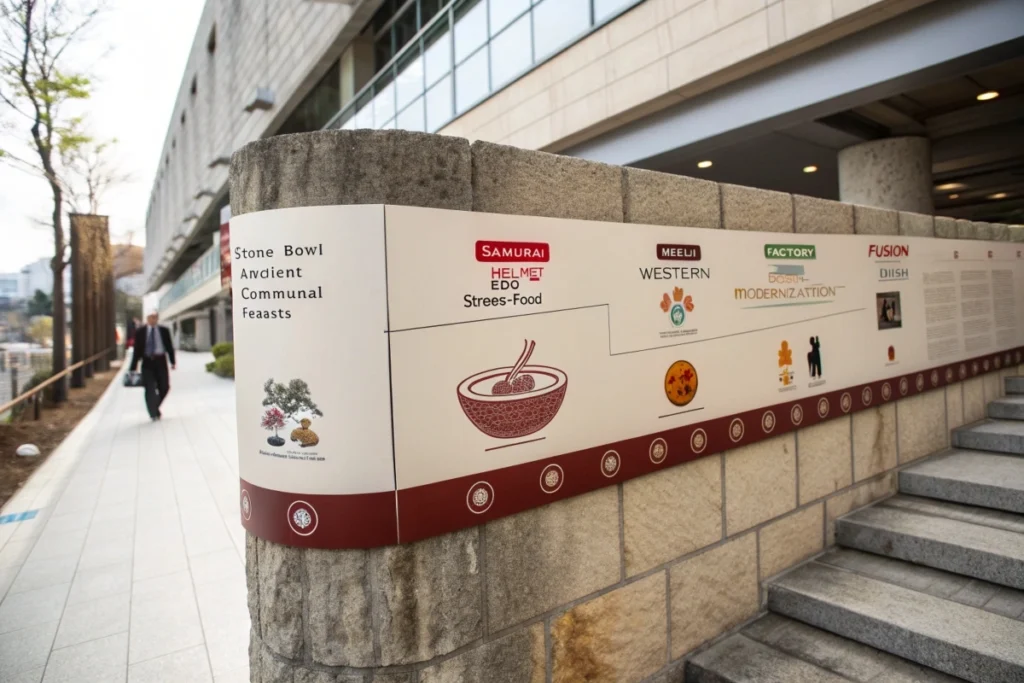
Practical Examples & Use Cases
Scenario 1: Minimalist Housewarming Party
A young couple invites close friends to celebrate their new apartment. They arrange a minimalist spread: a large wooden board layered with salmon and avocado maki, a bowl of edamame sprinkled with sea salt, and small plates of grilled yakitori. They also serve a pot of green tea, aligning with the cozy, low-key vibe. Despite the simplicity, guests rave about the freshness and the experience of sampling different flavors in a relaxed environment.
Scenario 2: Birthday Bash with Interactive Stations
A larger birthday party calls for interactive japanese party food stations. One corner is a DIY sushi roll table, where guests pick their fillings—spicy tuna, cucumber, imitation crab—and roll them in nori. Another station offers warm miso soup in disposable cups, plus a sauce bar featuring ponzu, spicy mayo, and ginger dressing. A final dessert station presents mochi ice cream in various flavors. The variety keeps the party lively, and guests enjoy building their own custom bites.
Scenario 3: Themed Corporate Event
A company hosts a Japanese-themed networking event. Decor includes modern, black-lacquered platters filled with assorted tempura, sushi, and mini soba noodle cups. Servers pass around small trays of karaage (Japanese fried chicken). They also offer sake cocktails garnished with citrus zest. The sleek presentation aligns with corporate elegance, while the flavors—sweet soy glazes, tangy pickles—cater to global palates. Colleagues bond over trying new tastes and discussing the artistry behind each dish.
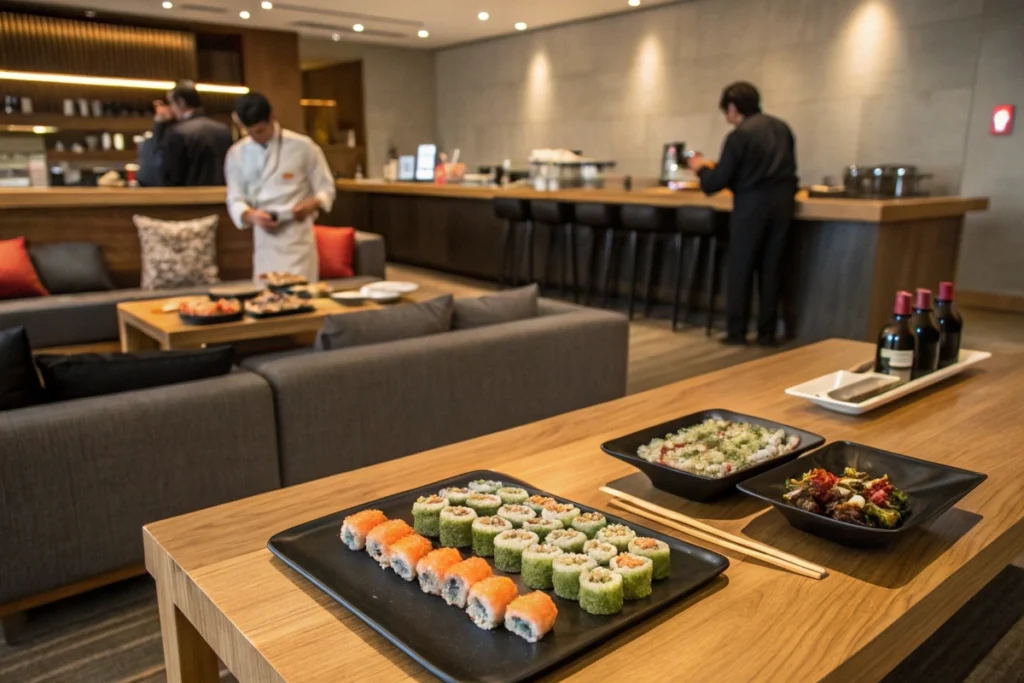
FAQs
Below are answers to commonly asked questions about japanese party food and party planning:
- What are some japanese party food ideas for beginners?
If you’re new to Japanese cooking, start with simple items like edamame, store-bought sushi rolls, and karaage (fried chicken). You can also make onigiri (rice balls) or cucumber sunomono salad—both are quick, no-fuss dishes that add authenticity to your table. - How can I make japanese food party platters look professional?
Presentation is key. Use lacquered trays or wooden boards, arrange items in neat rows, and add small decorative elements like fresh herbs or edible flowers. Also consider color variety: mix greens, oranges, and whites to create an eye-catching spread. - Any japanese themed party ideas for adults?
Adults might enjoy a sake tasting station or a build-your-own ramen bar. You could also incorporate a dress code inviting guests to wear traditional Japanese yukatas or modern outfits inspired by Tokyo street fashion. Don’t forget background music—traditional shamisen tunes or modern J-pop can set the mood. - What about japanese themed party games?
Chopstick competitions (transferring small objects like beans from one bowl to another) can be a fun ice-breaker. Trivia about Japan’s geography, culture, or pop culture also works well. If space allows, setting up a mini goldfish scooping (kingyo sukui) stall is a nostalgic Japanese festival game. - How can I accommodate dietary restrictions?
Japanese cuisine has plenty of vegetarian and gluten-free options if you use gluten-free soy sauce and check your miso brand. Offer tofu dishes, grilled vegetables, and vegan sushi rolls to ensure everyone feels included. - Where do I find easy Japanese meals for parties?
Look for recipes on trusted blogs or check out easy Japanese dishes to make. They provide step-by-step guidance for beginners, enabling you to create a balanced menu that appeals to all tastes.
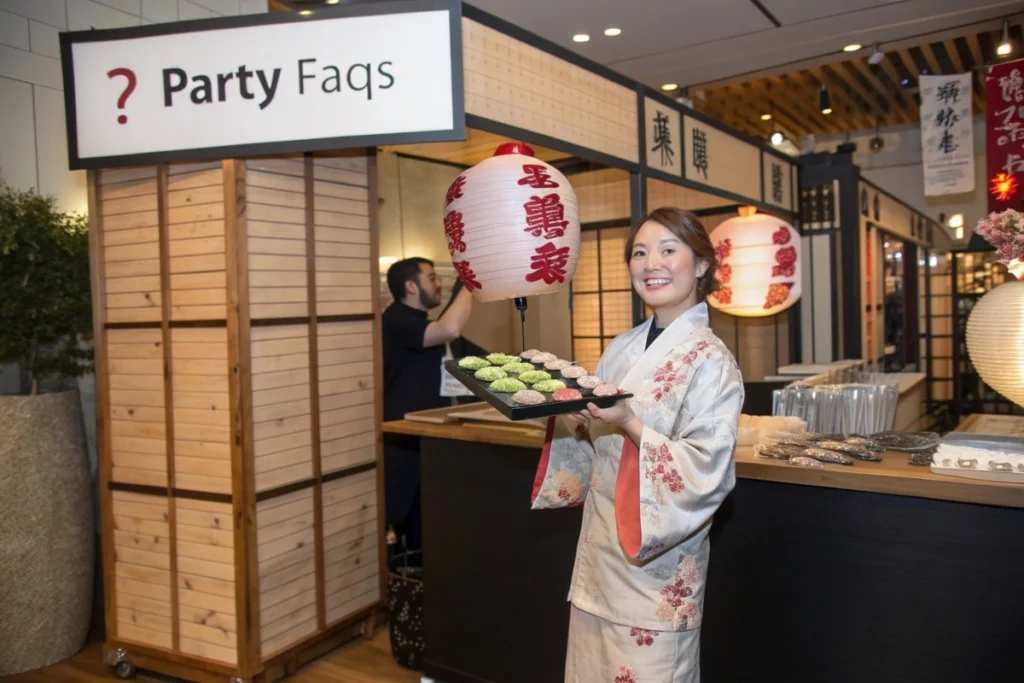
Conclusion
Organizing a memorable event with japanese party food requires creativity, but the rewards are immense. From mouthwatering sushi rolls to comforting bowls of miso soup, the flavors and presentation instantly captivate guests and transform ordinary gatherings into cultural feasts. By mixing classic recipes like yakitori or tempura with modern twists—such as sushi bakes or fusion sliders—you’ll delight palates of all ages.
Remember, details matter. Incorporating authentic tableware, thematic decor, and a variety of sauces or toppings can enhance the party’s overall ambiance. Consider highlighting sweet endings with mini desserts or mochi, and select beverage options—like sake or green tea—that complement your chosen menu. Once you explore these possibilities, you’ll realize how versatile and enjoyable Japanese cuisine can be in a party context.
Ready to take the leap? Start with one or two dishes that resonate with you, then expand your offerings as you gain confidence. If you’re craving more ideas, browse other Japanese dinner recipes for inspiration. Whatever you choose, your guests are bound to remember this cultural and gastronomic journey. It’s time to roll up your sleeves, put on some background music, and let the flavors of Japan turn your next party into an unforgettable celebration.
